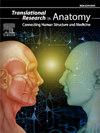Redefining lumbosacral transitional vertebrae classification: Morphological variation in a South African population
Q3 Medicine
引用次数: 0
Abstract
Background
Lumbosacral transitional vertebrae (LSTV) are common anatomical variants where the last lumbar vertebra demonstrates unilateral or bilateral enlargement of the transverse processes, with articulation or fusion to the sacrum. This radio-anatomical study sought to investigate the morphological characteristics of LSTV in the South African population and describe unique variations that enhance the traditional Castellvi classification.
Methods
A retrospective radiographic review was performed on 3096 consecutive thoracoabdominal pelvic radiographs from two South African hospitals. Targeted osteological appraisal was conducted on selected skeletons containing LSTV sourced from the Raymond Dart Collection of Modern Human Skeletons. The presence of LSTV was classified according to Castellvi, identifying Types II, III, and IV, unilateral and bilateral subtypes.
Results
The prevalence of LSTV was 10 %. Morphological distribution was as follows: Type II (67.9 %), Type III (27.6 %), and Type IV (4.5 %). Subtype frequencies were IIA (41.9 %), IIB (26.0 %), IIIB (21.8 %), and IV (5.8 %). Laterality showed a predominance of bilateral cases (47.7 %), followed by left- (26.6 %) and right-sided (21.1 %) variants. Type IV morphology could not be classified by side using traditional methods. Transverse processes at the LSTV level were significantly longer than those in matched controls (p < 0.05).
Conclusion
This study proposes two refinements to the Castellvi system: First, Type IV morphology should be assigned left or right at the side of the lumbosacral fusion. Second, a novel transversoiliac articulation was associated with Type II morphology, representing a previously undescribed feature in LSTV morphology. These modifications may enhance diagnostic precision, support recognition of Bertolotti syndrome, and formulate appropriate treatment strategies.
重新定义腰骶过渡椎分类:南非人群的形态变异
腰骶过渡椎(LSTV)是一种常见的解剖变异,其中最后一节腰椎表现为单侧或双侧横突扩大,与骶骨关节或融合。本放射解剖学研究旨在调查南非人群LSTV的形态学特征,并描述增强传统Castellvi分类的独特变异。方法对南非两家医院连续拍摄的3096张胸腹盆腔x线片进行回顾性分析。对来自Raymond Dart Collection of Modern Human skeleton的含有LSTV的骨骼进行有针对性的骨学鉴定。根据Castellvi对LSTV的存在进行分类,分为II型、III型和IV型、单侧和双侧亚型。结果LSTV患病率为10%。形态分布为ⅱ型(67.9%)、ⅲ型(27.6%)、ⅳ型(4.5%)。亚型频次为IIA(41.9%)、IIB(26.0%)、IIIB(21.8%)和IV(5.8%)。侧侧病变以双侧病变为主(47.7%),其次为左侧病变(26.6%)和右侧病变(21.1%)。IV型形态学不能用传统方法进行侧分。LSTV水平的横突明显长于匹配对照组(p <;0.05)。本研究提出了对Castellvi系统的两种改进:首先,IV型形态学应分配在腰骶融合侧的左侧或右侧。其次,一种新的横髂关节与II型形态学有关,代表了LSTV形态学中先前未描述的特征。这些修改可以提高诊断的准确性,支持Bertolotti综合征的识别,并制定适当的治疗策略。
本文章由计算机程序翻译,如有差异,请以英文原文为准。
求助全文
约1分钟内获得全文
求助全文
来源期刊

Translational Research in Anatomy
Medicine-Anatomy
CiteScore
2.90
自引率
0.00%
发文量
71
审稿时长
25 days
期刊介绍:
Translational Research in Anatomy is an international peer-reviewed and open access journal that publishes high-quality original papers. Focusing on translational research, the journal aims to disseminate the knowledge that is gained in the basic science of anatomy and to apply it to the diagnosis and treatment of human pathology in order to improve individual patient well-being. Topics published in Translational Research in Anatomy include anatomy in all of its aspects, especially those that have application to other scientific disciplines including the health sciences: • gross anatomy • neuroanatomy • histology • immunohistochemistry • comparative anatomy • embryology • molecular biology • microscopic anatomy • forensics • imaging/radiology • medical education Priority will be given to studies that clearly articulate their relevance to the broader aspects of anatomy and how they can impact patient care.Strengthening the ties between morphological research and medicine will foster collaboration between anatomists and physicians. Therefore, Translational Research in Anatomy will serve as a platform for communication and understanding between the disciplines of anatomy and medicine and will aid in the dissemination of anatomical research. The journal accepts the following article types: 1. Review articles 2. Original research papers 3. New state-of-the-art methods of research in the field of anatomy including imaging, dissection methods, medical devices and quantitation 4. Education papers (teaching technologies/methods in medical education in anatomy) 5. Commentaries 6. Letters to the Editor 7. Selected conference papers 8. Case Reports
 求助内容:
求助内容: 应助结果提醒方式:
应助结果提醒方式:


